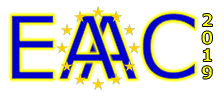Speaker
Description
The plasma source during AWAKE run 1 consists of a 10 meter long rubidium vapor source ionized by a laser pulse from a 4 TW titanium:sapphire system focused to a mm spot size. Because the plasma column geometry can have an effect on the formation of the proton driven plasma wakefields when the plasma skin depth approaches the size of the plasma column, the geometry needs to be understood. Since several resonances associated with atomic state transitions of the valence electron are within the bandwidth of the laser pulse, the pulse experiences strong nonlinear effects that can cause stretching and nonlinear focusing thereby dramatically affecting the resulting plasma column due changes in intensity. By experimentally studying the time resolved transverse profile and the spectrum from the output laser radiation, as well as the transverse profile of plasma column at the end of the vapor source using a schlieren imaging technique as a function of input intensity and rubidium density, a numerical model for the laser propagation is qualified. Using the propagation model, potential design studies for AWAKE run 2 are discussed.

